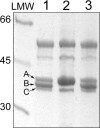Immunization of pigs to prevent disease in humans: construction and protective efficacy of a Salmonella enterica serovar Typhimurium live negative-marker vaccine
- PMID: 17296750
- PMCID: PMC1865763
- DOI: 10.1128/IAI.01908-06
Immunization of pigs to prevent disease in humans: construction and protective efficacy of a Salmonella enterica serovar Typhimurium live negative-marker vaccine
Abstract
Zoonotic infections caused by Salmonella enterica serovar Typhimurium pose a constant threat to consumer health, with the pig being a particularly major source of multidrug-resistant isolates. Vaccination, as a promising approach to reduce colonization and shedding, has been scarcely used, as it interferes with current control programs relying on serology as a means of herd classification. In order to overcome this problem, we set out to develop a negative-marker vaccine allowing the differentiation of infected from vaccinated animals (DIVA). Applying an immunoproteomic approach with two-dimensional gel electrophoresis, Western blot, and quadrupole time-of-flight tandem mass spectrometry, we identified the OmpD protein as a suitable negative marker. Using allelic exchange, we generated an isogenic mutant of the licensed live vaccine strain Salmoporc and showed that virulence of Salmoporc and that of the mutant strain, SalmoporcDeltaompD, were indistinguishable in BALB/c mice. In a pig infection experiment including two oral immunizations with SalmoporcDeltaompD and challenge with a multiresistant S. enterica serovar Typhimurium DT104 clinical isolate, we confirmed the protective efficacy of SalmoporcDeltaompD in pigs, showing a significant reduction of both clinical symptoms and colonization of lymph nodes and intestinal tract. OmpD immunogenic epitopes were determined by peptide spot array analyses. Upon testing of several 9-mer peptides, each including an immunogenic epitope, one peptide (positions F(100) to Y(108)) that facilitated the detection of infected animals independent of their vaccination status (DIVA function) was identified. The approach described overcomes the problems currently limiting the use of bacterial live vaccines and holds considerable potential for future developments in the field.
Figures




Similar articles
-
Salmonella DIVA vaccine reduces disease, colonization and shedding due to virulent S. Typhimurium infection in swine.J Med Microbiol. 2017 May;66(5):651-661. doi: 10.1099/jmm.0.000482. Epub 2017 May 18. J Med Microbiol. 2017. PMID: 28516860 Free PMC article.
-
Evaluation of Salmonella enterica serovar Typhimurium and Choleraesuis slyA mutant strains for use in live attenuated oral vaccines.Comp Immunol Microbiol Infect Dis. 2011 Sep;34(5):399-409. doi: 10.1016/j.cimid.2011.07.001. Epub 2011 Aug 12. Comp Immunol Microbiol Infect Dis. 2011. PMID: 21840053 Clinical Trial.
-
Use of a live attenuated Salmonella enterica serovar Typhimurium vaccine on farrow-to-finish pig farms.Vet J. 2014 Nov;202(2):303-8. doi: 10.1016/j.tvjl.2014.09.012. Epub 2014 Sep 16. Vet J. 2014. PMID: 25278382
-
Live attenuated vaccines for invasive Salmonella infections.Vaccine. 2015 Jun 19;33 Suppl 3(0 3):C36-41. doi: 10.1016/j.vaccine.2015.04.029. Epub 2015 Apr 19. Vaccine. 2015. PMID: 25902362 Free PMC article. Review.
-
Live Attenuated Human Salmonella Vaccine Candidates: Tracking the Pathogen in Natural Infection and Stimulation of Host Immunity.EcoSal Plus. 2016 Nov;7(1):10.1128/ecosalplus.ESP-0010-2016. doi: 10.1128/ecosalplus.ESP-0010-2016. EcoSal Plus. 2016. PMID: 27809955 Free PMC article. Review.
Cited by
-
Mapping polyclonal antibody responses to bacterial infection using next generation phage display.Sci Rep. 2016 Apr 13;6:24232. doi: 10.1038/srep24232. Sci Rep. 2016. PMID: 27072017 Free PMC article.
-
Mapping B-cell responses to Salmonella enterica serovars Typhimurium and Enteritidis in chickens for the discrimination of infected from vaccinated animals.Sci Rep. 2016 Aug 11;6:31186. doi: 10.1038/srep31186. Sci Rep. 2016. PMID: 27510219 Free PMC article.
-
A proteomic approach to the development of DIVA ELISA distinguishing pigs infected with Salmonella Typhimurium and pigs vaccinated with a Salmonella Typhimurium-based inactivated vaccine.BMC Vet Res. 2016 Nov 11;12(1):252. doi: 10.1186/s12917-016-0879-1. BMC Vet Res. 2016. PMID: 27835998 Free PMC article.
-
Immunogenic potential of a Salmonella Typhimurium live vaccine for pigs against monophasic Salmonella Typhimurium DT 193.BMC Vet Res. 2017 Nov 17;13(1):343. doi: 10.1186/s12917-017-1271-5. BMC Vet Res. 2017. PMID: 29149900 Free PMC article.
-
Efficacy of a Self-Vaccination Strategy for Influenza A Virus, Mycoplasma hyopneumoniae, Erysipelothrix rhusiopathiae, and Lawsonia intracellularis in Swine.Vaccines (Basel). 2025 Feb 24;13(3):229. doi: 10.3390/vaccines13030229. Vaccines (Basel). 2025. PMID: 40266075 Free PMC article.
References
-
- Berends, B. R., F. van Knapen, D. A. Mossel, S. A. Burt, and J. M. Snijders. 1998. Impact on human health of Salmonella spp. on pork in The Netherlands and the anticipated effects of some currently proposed control strategies. Int. J. Food Microbiol. 44:219-229. - PubMed
-
- Besser, T. E., M. Goldoft, L. C. Pritchett, R. Khakhria, D. D. Hancock, D. H. Rice, J. M. Gay, W. Johnson, and C. C. Gay. 2000. Multiresistant Salmonella Typhimurium DT104 infections of humans and domestic animals in the Pacific Northwest of the United States. Epidemiol. Infect. 124:193-200. - PMC - PubMed
-
- Capua, I., G. Cattoli, and S. Marangon. 2004. DIVA—a vaccination strategy enabling the detection of field exposure to avian influenza. Dev. Biol. (Basel) 119:229-233. - PubMed
-
- Casewell, M., C. Friis, E. Marco, P. McMullin, and I. Phillips. 2003. The European ban on growth-promoting antibiotics and emerging consequences for human and animal health. J. Antimicrob. Chemother. 52:159-161. - PubMed
Publication types
MeSH terms
Substances
Associated data
- Actions
LinkOut - more resources
Full Text Sources
Other Literature Sources
Medical
Molecular Biology Databases
Miscellaneous

